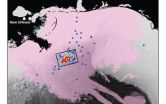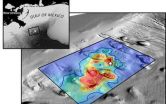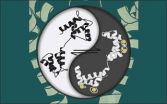(Press-News.org) Where's the remaining oil from the 2010 Deepwater Horizon disaster in the Gulf of Mexico?
The location of 2 million barrels of oil thought to be trapped in the deep ocean has remained a mystery. Until now.
Scientist David Valentine of the University of California, Santa Barbara (UCSB) and colleagues from the Woods Hole Oceanographic Institution (WHOI) and the University of California, Irvine, have discovered the path the oil followed to its resting place on the Gulf of Mexico sea floor.
The findings appear today in the journal Proceedings of the National Academy of Sciences.
"This analysis provides us with, for the first time, some closure on the question, 'Where did the oil go and how did it get there?'" said Don Rice, program director in the National Science Foundation's (NSF) Division of Ocean Sciences, which funded the research along with NSF's Division of Earth Sciences.
"It also alerts us that this knowledge remains largely provisional until we can fully account for the remaining 70 percent."
For the study, the scientists used data from the Natural Resource Damage Assessment conducted by the National Oceanic and Atmospheric Administration.
The U.S. government estimates the Macondo Well's total discharge--from April until the well was capped in July--at 5 million barrels.
By analyzing data from more than 3,000 samples collected at 534 locations over 12 expeditions, the researchers identified a 1,250-square-mile patch of the sea floor on which four to 31 percent of the oil trapped in the deep ocean was deposited. That's the equivalent of 2 to 16 percent of the total oil discharged during the accident.
The fallout of oil created thin deposits that are most extensive to the southwest of the Macondo Well. The oil is concentrated in the top half-inch of the sea floor and is patchily distributed.
The investigation focused primarily on hopane, a nonreactive hydrocarbon that served as a proxy for the discharged oil.
The researchers analyzed the distribution of hopane in the northern Gulf of Mexico and found that it was concentrated in a thin layer at the sea floor within 25 miles of the ruptured well, clearly implicating Deepwater Horizon as the source.
"Based on the evidence, our findings suggest that these deposits are from Macondo oil that was first suspended in the deep ocean, then settled to the sea floor without ever reaching the ocean surface," said Valentine, a biogeochemist at UCSB.
"The pattern is like a shadow of the tiny oil droplets that were initially trapped at ocean depths around 3,500 feet and pushed around by the deep currents.
"Some combination of chemistry, biology and physics ultimately caused those droplets to rain down another 1,000 feet to rest on the sea floor."
Valentine and colleagues were able to identify hotspots of oil fallout in close proximity to damaged deep-sea corals.
According to the researchers, the data support the previously disputed finding that these corals were damaged by the Deepwater Horizon spill.
"The evidence is becoming clear that oily particles were raining down around these deep sea corals, which provides a compelling explanation for the injury they suffered," said Valentine.
"The pattern of contamination we observe is fully consistent with the Deepwater Horizon event but not with natural seeps--the suggested alternative."
While the study examined a specified area, the scientists argue that that the observed oil represents a minimum value. They believe that oil deposition likely occurred outside the study area but so far has largely evaded detection because of its patchiness.
"These findings," said Valentine, "should be useful for assessing the damage caused by the Deepwater Horizon spill, as well as planning future studies to further define the extent and nature of the contamination.
"Our work can also help assess the fate of reactive hydrocarbons, test models of oil's behavior in the ocean, and plan for future spills."
INFORMATION:
Co-authors of the paper are G. Burch Fisher and Sarah C. Bagby of UCSB; Robert K. Nelson, Christopher M. Reddy and Sean P. Sylva of WHOI and Mary A. Woo of University of California, Irvine.
The first images of a nova during its early fireball stage--when it ejects material, and gases expand and cool--show that this activity is more complicated than predicted.
That is the conclusion, published in the current issue of Nature, from a research collaboration led by Georgia State University Astronomer Gail Schaefer that includes 37 researchers (many who are National Science Foundation (NSF)-funded) from 17 institutions. The researchers observed the expanding thermonuclear fireball from a nova that erupted last year in the constellation Delphinus.
"This is ...
The uncontrolled growth of cancer cells arises from their ability to hijack the cell's normal growth program and checkpoints. Usually after therapy, a second cancer-signaling pathway will open after the primary one shuts down — creating an ingenious escape route for the cancer cell to survive. The answer, say Case Western Reserve researchers, is to anticipate and block that back-up track by prescribing two drugs from the start. The results of the project, led by Ruth Keri, PhD, Professor and Vice Chair Department of Pharmacology, and Associate Director for Basic Research ...
1. Study: Prompt isolation of symptomatic patients is key to eliminating Ebola
Isolating the sickest Ebola-infected individuals before they progress into their late phase of illness can effectively eliminate the Ebola epidemic in Liberia, according to a modeling study being published in Annals of Internal Medicine. Currently, West Africa is in the midst of the largest and deadliest Ebola epidemic ever recorded. Liberia has been especially hard-hit with more than 3,500 infections and 2,000 deaths in the past three months. Researchers developed a random transmission model ...
COLUMBUS, Ohio – The drug erlotinib is highly effective in treating advanced-stage lung cancer patients whose tumors have a particular gene change, but when the same drug is used for patients with early-stage tumors with the same gene change, they actually fare worse than if they took nothing. A study by researchers at The Ohio State University Comprehensive Cancer Center – Arthur G. James Cancer Hospital and Richard J. Solove Research Institute (OSUCCC – James) and at Cincinnati Children's Hospital might show why.
Oncologists use erlotinib to treat ...
SPOKANE, Wash.—Americans are in a world of hurt.
Nearly one in five U.S. adults are in pain most every day for spells of three months or longer, according to an analysis by Jae Kennedy, professor of health policy and administration at Washington State University Spokane. The estimated 39 million adults in persistent pain outnumber the residents of California.
Previous studies have said so much pain costs hundreds of billions of dollars a year in lost productivity and health care. And that doesn't take into account pain's psychic toll.
"A sizeable portion of American ...
Chicago, October 27, 2014—The Associated Press-NORC Center for Public Affairs Research today released the results of a major new study and related reports on the recovery from Superstorm Sandy in 12 New York and New Jersey neighborhoods hard hit by the 2012 storm.
It is the second AP-NORC study that has focused on the aftermath of Superstorm Sandy, with findings that emphasize the important role social factors play in a neighborhood's resilience: the ability of people and their social systems to survive, adapt and continue moving forward after a disaster. Funding ...
Researchers at McGill University have succeeded in simultaneously observing the reorganizations of atomic positions and electron distribution during the transformation of the "smart material" vanadium dioxide (VO2) from a semiconductor into a metal – in a timeframe a trillion times faster than the blink of an eye.
The results, reported Oct. 24 in Science, mark the first time that experiments have been able to distinguish changes in a material's atomic-lattice structure from the relocation of the electrons in such a blazingly fast process.
The measurements were ...
Influencers trump belief that doctors adopt a new therapy by watching others use it
Surprisingly long road from FDA approval to use by doctors
New technology is like an influential colleague -- opinionated but not too bossy
Doctors need to be reminded every five to seven days
CHICAGO --- Doctors are more likely to try a new therapy when they are persuaded to do so by an influential colleague, reports a new Northwestern University study whose findings on adopting innovations also have relevance for business, education and research.
The authors have used the ...
A common protein plays a different role than previously thought in the opening and closing of channels that let ions flow in and out of our cells, researchers at Johns Hopkins report. Those channels are critical to life, as having the right concentrations of sodium and calcium ions in cells enables healthy brain communication, heart contraction and many other processes. The new study reveals that a form of calmodulin long thought to be dormant actually opens these channels wide. The finding is likely to bring new insight into disorders caused by faulty control of these ...
CLEVELAND -- A study published in the journal International Scholarly Research Notices (ISRN) Stroke found that overall knowledge about stroke in Uganda was poor, although knowing what to do for a stroke – go to the hospital – was good.
Researchers from higher education institutions in Uganda collaborated with those from Case Western Reserve University and University Hospitals Case Medical Center to assess residents' knowledge of stroke symptoms and treatment options. To date, public perception and level of knowledge of stroke warning signs and risk factors ...




